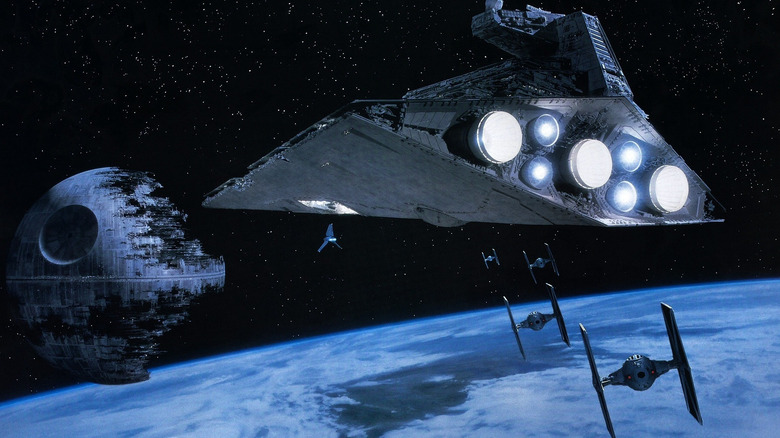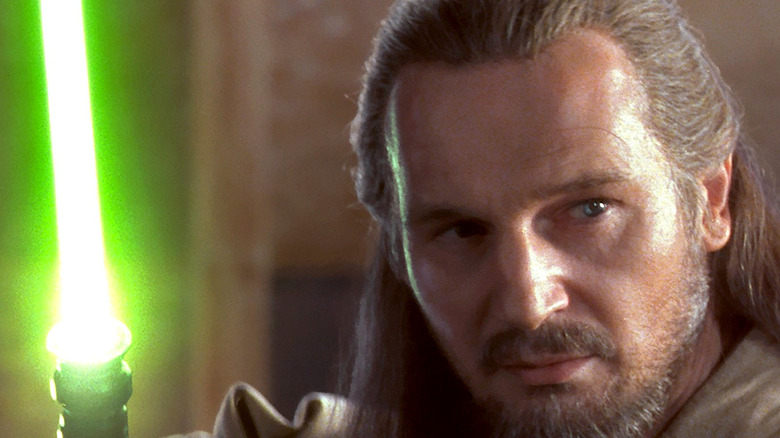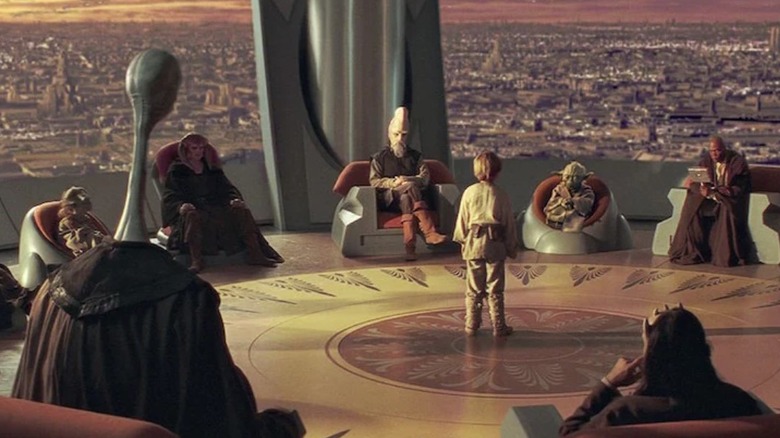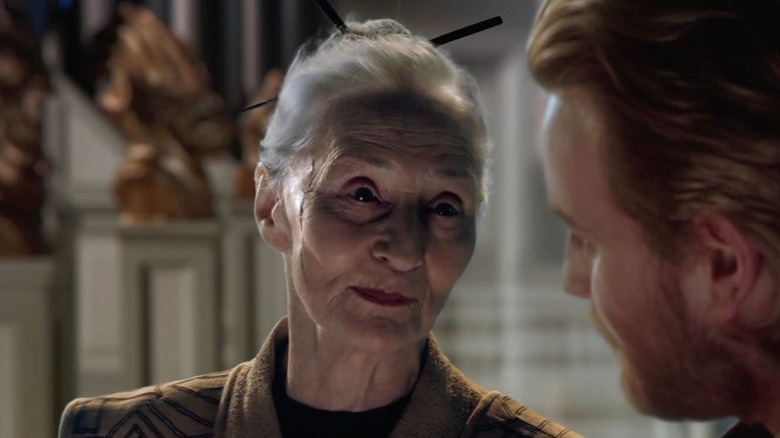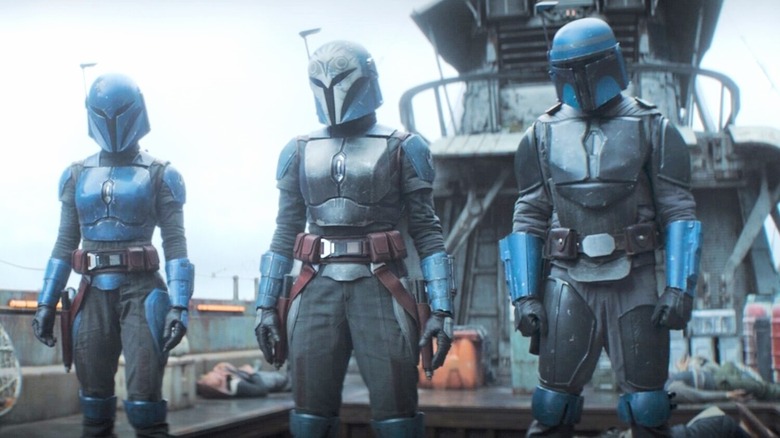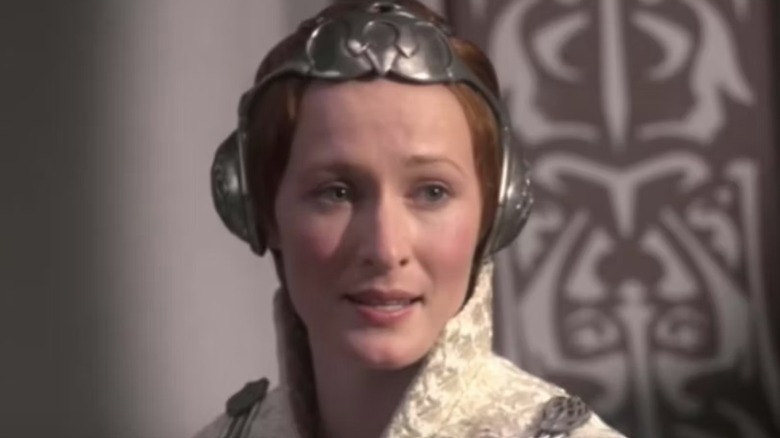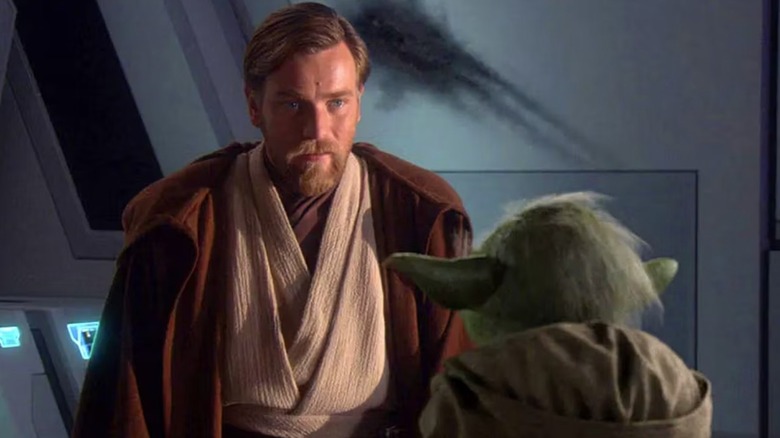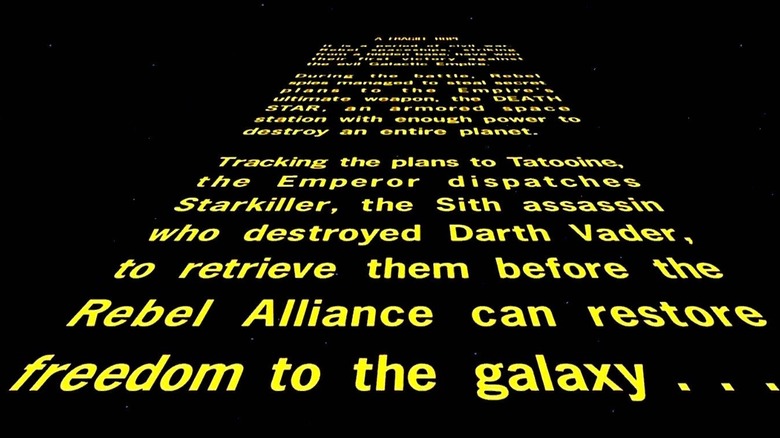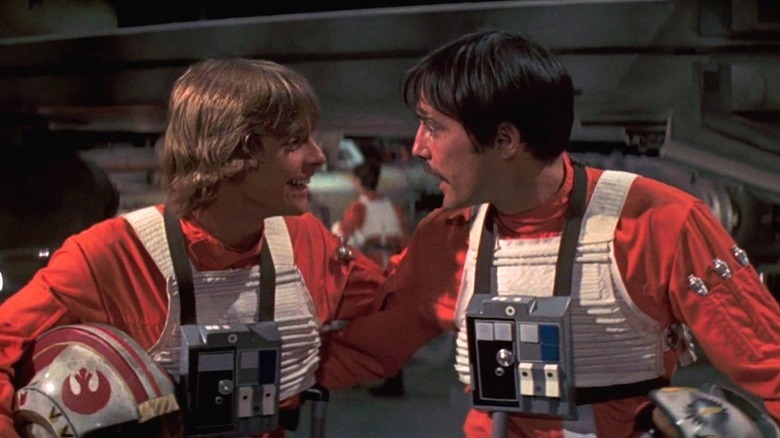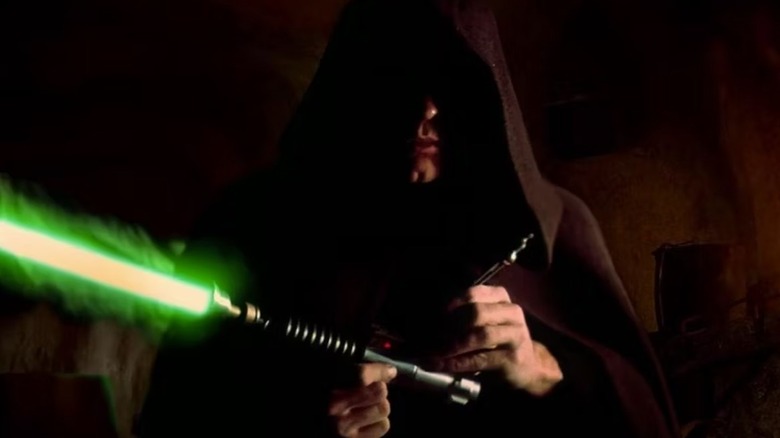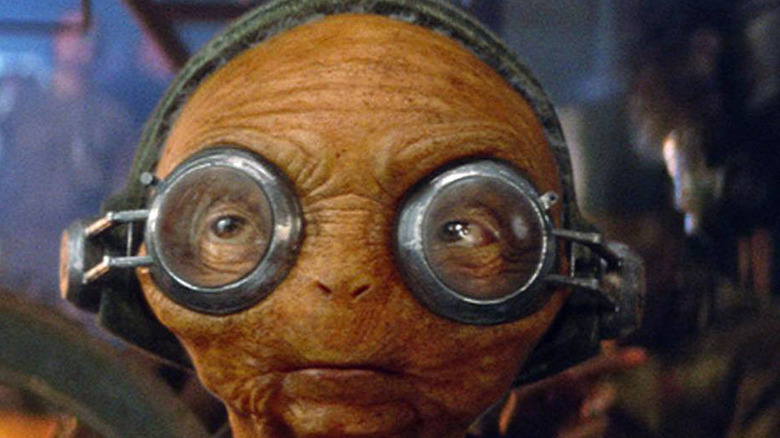Star Wars Deleted Scenes That Could've Changed Everything
"Star Wars" fans are fond of gathering even the most arcane knowledge, and before YouTube and the flood of the Extended Universe they didn't have much to dissect beyond what was on the screen. For decades, the faithful were doomed to circulate VHS tapes of "The Star Wars Holiday Special" or discuss abandoned scenes in terms of "I heard." Movie novelizations offered tantalizing descriptions of deleted scenes, such as Luke, Leia, and Han making their way through a wicked Tatooine sandstorm during "Return of the Jedi." The removal of such scenes often made sense, since they didn't move the story forward or the themes or character development intended for them were already expressed elsewhere.
With the advent of data-heavy DVDs and the long process of CGI, half-completed or deleted clips became more widely available. Many fans include them on the edge of canon, as long as they weren't later contradicted in the franchise. Some of these survive as historical curiosities. In other cases, the cuts were repurposed into plots or elements explored in future series, movies, or novels. A good Star Wars idea is always a good Star Wars idea—no matter what winds up on Disney+. Deleted scenes fall into two categories: One set solves mysteries prompted by confusing remnants that survived in the film or episode, while the other indicates early philosophical or plot directions that represented the intent of the directors or showrunners at the moment ... trajectories that could have changed everything.
Qui-Gon takes out a Sith probe droid
THE SCENE: Early in "The Phantom Menace," Qui-Gon Jinn and Anakin Skywalker were minding their own business, jauntily setting off a course of events that would result in intergalactic war and wipe out millions, when Qui-Gon suddenly turned around and sliced down a probe droid that Darth Maul set upon them. He examined it, then told Anakin they needed to hurry.
WHAT COULD HAVE BEEN: The relevant footage in this scene runs for 22 seconds, and leaving it in would have:
1) Explained, just as Anakin yelled into the wind, why the two were sprinting back to the ship.
2) Revealed how Darth Maul was able to precisely locate the pair.
3) Visually established the Force sensory abilities of an accomplished, Temple-trained Jedi over those of a Sith trainee (this spin-and-slice of Qui-Gon's was just stupendous).
4) Heightened tension rather than suddenly presenting a Sith Lord on a motorbike intent upon annihilating a random third-grader.
5) Potentially blunted criticism of people flummoxed by all four of these things.
This was cut, and a painstakingly CGI-rendered Jar-Jar Binks fart joke was judged worthy of inclusion. If ever you need to remember why many fans are still teeming with salt about the prequels, remember these 22 seconds.
Yaddle speaks!
THE SCENE: In "The Phantom Menace," Yaddle contributed her opinion to the Jedi Council as to whether or not the Jedi should train Anakin.
WHAT COULD HAVE BEEN: Although Yoda's species was previously understood to be rare, the introduction of Yaddle, a female member of the Jedi council, in "The Phantom Menace" suggested there were more creatures like him out there, and that maybe these people were particularly Force-sensitive. While there's no way Lucasfilm could have foreseen the global embrace of Baby Yoda two decades in the future, it's a safe bet that hearing Yaddle talk so early on would've impacted Grogu's evolution. Does every member of Yoda's species put verbs and adjectives before the rest of an otherwise intelligible sentence, or was he just wizened beat poet? Non-canon species members of the species, Vandar Tokare and Oteg from "Knights of the Old Republic," spoke like grammar bee champs. The 2021 novel "Out of the Shadows" does feature Yaddle speaking, and not in Yoda's distinctive speech patterns, but this was released two years after "The Mandalorian" debuted. The 2019 book "Alien Archive" described her as "very quiet and kind," but deadly.
Yaddle's appearances in Legends comics (now non-canon) portray her as using a Yoda-like syntax. In any case, fans didn't hear her voice in live-action or animation until 2022, when "Tales of the Jedi" premiered, where she speaks normally. Assuming that Baby Yoda would have remained the same species had Yaddle played a bigger role in the prequels, the fanbase would probably have headed into "The Mandalorian" with a better understanding of where he came from and what his people or planet were like. Wrapping Grogu in the mystery of how he survived Order 66 is probably puzzling enough for most, but other questions surrounding the pint-sized Padawan are anthropological as well as plot-related. The differences between Yoda and Yaddle's speaking patterns, paired with the fact that Grogu has done little more than babble and coo, heightens the ambiguity and deepens a sense of protection around this old green baby. Dave Filoni wisely took advantage of the mystique surrounding the species when designing Mando's bounty. Cute as he is, more familiarity would've diminished the phenomenon that Grogu became.
Jocasta Nu and Obi-Wan Kenobi discuss Dooku
THE SCENE: Obi-Wan Kenobi and Jedi librarian Jocasta Nu had a discussion about the lost Jedi, known as "The Lost Twenty," in "Attack of the Clones."
WHAT COULD HAVE BEEN: "The Lost" were Masters of the Jedi Order who separated from the group at one time or another because they objected to its principals, decisions, or manner of living. In this context, Jocasta and Obi-Wan discussed Count Dooku before his bust in the Jedi Archives. Dooku — Qui-Gon Jinn's former master — left the Order due to its decision to place itself under the Republic's military authority. Like Ahsoka, he was disillusioned with the Order, but like Anakin he allowed that frustration to absorb him into the Dark Side.
This edit did both Jocasta as well as Dooku dirty. As her part survived in the film, Jocasta is presented as an uptight librarian, which carried over to her portrayal in "Clone Wars." Yet this brief exchange revealed a great deal about both characters. Jocasta gave Obi-Wan a friendly greeting and even affectionately stroked the side of Dooku's stone-cut image. "He was one of the most brilliant Jedi I've had the privilege of knowing," she said in warm tones. "One might say he was always a bit out of step with the decisions of the Council," Jocasta told Kenobi, adding that he and Qui-Gon were "very individual thinkers, idealists." Leaving that descriptor in would have uncovered a great deal about the influences behind Qui-Gon's constant clashes with the Council. Worst of all, without this scene, viewers were left with a villain who was briefly mentioned once, then glided in out of nowhere with a cape and a curved lightsaber. The library scene, in just a few seconds, shaded his character and presented the varying aspects of his decisions. Fans can be forgiven for not really ever caring about Dooku because this movie never gave them the chance.
Darth Maul murders an innocent bystander
THE SCENE: In the episode "Revenge" from Season 4 of "Clone Wars," Darth Maul killed an innocent bystander for whom Obi-Wan laid down his lightsaber.
WHAT COULD HAVE BEEN: This episode featured everyone's favorite bisected Sith Lord, Darth Maul, and his brother Savage Opress. Some scenes and plotlines in "Clone Wars" were brutal by Star Wars standards, but this one was savage. It called for Maul to murder his hostage by igniting his lightsaber through his head.
In this reunion with Obi-Wan, Maul was struggling to recover his memory after years of insanity as a half-mechanical spider, and who can blame him? He wasn't entirely sure what was happening, but he knew it involved Obi-Wan. The discarded scene would have further informed the fanbase about Obi-Wan and Maul's positions on opposite poles of the Force. True to the Jedi code, Obi-Wan did not hesitate to surrender even his "life" (his priceless lightsaber) for someone he didn't even know existed until Maul took him hostage. A Jedi's lightsaber was much more than a symbol, it meant that Obi-Wan was voluntarily hobbling himself in his inevitable escape attempt. By handing over the lightsaber, he could very well have been trading in his own life ... and he knew it. He did it anyway. It's tempting to think that Darth Maul, in all his evil, didn't realize and appreciate what this meant, but he most certainly did. Although already unhinged enough to warrant his own "Dateline" episode, Maul wielded Kenobi's own goodness as an even more effective weapon than the lightsaber. This scene would have served the episode well, as it underlined Maul's utter brutality and would have rendered Obi-Wan's gentle, forgiving treatment in "Rebels" even more sacrificial and generous.
Bo-Katan and Death Watch Save Children
THE SCENE: Season 5 of "Clone Wars" boasted an episode called "Shades of Reason," in which Bo-Katan and some members of Death Watch rescued a few children in Peace Park on Mandalore. They save the kids from the Black Sun and Pyke cartels.
WHAT COULD HAVE BEEN: This deletion is more of a "What Could Be." "Shades of Reason" was a hinge episode in this arc with a treasure trove of Important "Star Wars" things. It's lekku-deep in fake rescues, jailbreaks, triple-crossing, and the Darksaber.
Those who watch "The Mandalorian" — and watch it closely — had their attention caught by the words "Death Watch" and "rescue children." Young Din Djarin's life was saved by a group of Mandalorians, and "Clone Wars" fans were aghast when they saw that little Mando, the future dad-hero, was in the arms of a Mandalorian bearing a Death Watch sigil on his armor. Notably, the sigil was also used by Clan Vizsla, which figured heavily in this episode. However, outside of Mando's interactions with Paz Vizsla, his potential connection with Death Watch has yet to resurface in "The Mandalorian." Had this scene survived intact, it might have led the franchise into a more thorough exploration of Death Watch as a clan that takes in refugees as their own, a direction that could've impacted Din's backstory. This could still happen, of course. Repackaging the child-saving event from the cut footage for "The Mandalorian" could prove consequential in a number of ways that the fanbase doesn't yet know. The sight of the sigil could simply function as a wave to "Clone Wars" devotees, or hint at some Mandalore-based clashes to come in Season 3 of "The Mandalorian."
Senators sow the seeds of the Rebel Alliance
THE SCENE: Mid-"Revenge of the Sith," Bail Organa, Mon Mothma, Padme Amidala, and others gather to discuss their concerns about Palpatine's power.
WHAT COULD HAVE BEEN: Largely thanks to the success of "Rogue One" and the release of "Andor," this scene stands as one of the most famous deleted scenes from all nine films. However, it's easy to see why it was memory-holed from the final cut.
On the surface, it didn't do much to advance the plot, but it had a tremendous impact on character development. Padme asked if Palpatine would dismantle the Senate, but Mon Mothma bitterly said that there was no reason for him to do that, as the Senate was pretty much a figurative body at that point. This scene reflected well on neither Organa nor Padme, who came off (respectively) as the oiliest politician who ever oiled and a second-round "Bachelor" also-ran who somehow found herself in a Rock The Vote ad. This scene was dominated by the forceful presence of Mon Mothma, who in mere seconds established herself as an idealist who wanted a better galaxy but also wisely perceived the political situation for what it was. It laid the groundwork for her galvanizing speech in "Return of the Jedi" and proved that she was the ideal leader for the New Republic. Knowing Mon Mothma better through this scene could have prevented her from remaining the underrated character she still is.
The Fake Jedi
THE SCENE: Yoda and Obi-Wan Kenobi went to the Jedi Temple after Order 66, where clone troopers disguised as Jedi attempted to stop them.
WHAT MIGHT HAVE BEEN: This sequence was traced in the novelization of "Revenge of the Sith," and involved a long, complicated dash through the Jedi Temple as Obi-Wan and Yoda snuck around their occupied home to disable a false "return immediately" signal. A version of it survived in the LEGO game of the film, and an early form of the scene was released on DVD. The second half remains in the movie, although the clone's Jedi robes were digitally replaced with traditional clone armor.
They should have kept the robes. They were the very robes of the Jedi that Anakin and the clones just massacred. This would have fit with the trilogy's theme of hiding true intent: Jedi posed as Sith, a beleaguered Emperor was a dictator in disguise, and Padme pretended her marriage never happened. Enemies waited behind a façade of trust, and two Jedi Masters were forced to hide as they struck down former friends and stole through their own sacred space. Even the origin of this small squad layered in new meaning: The clones depicted here were from the 501st Legion, Anakin's own men, and they followed him without question. Anakin was no longer a Jedi, and he and Palpatine corrupted these loyal clones as well. Obi-Wan's banter before the shooting started ("You clones make terrible Jedi") would have undercut the utter tragedy of the moment, but the deception should have stayed. This scene delayed the real lightsaber fireworks for a few seconds, but it would have served the artistic goals of the film far more than other, longer sequences.
A title crawl for Rogue One
THE SCENE: A traditional title crawl was prepared for "Rogue One," but deleted.
WHAT MIGHT HAVE BEEN: When a person sits down to a "Star Wars" movie, five things should happen, in order:
1) Fanfare and Lucasfilm logo
2) "A long time ago in a galaxy far, far away..."
3) JOHN WILLIAMS BLLLAAAAAAAAAAAARRRRRRRRE
4) Title crawl
5) Spaceship!
"Rogue One," had none of this. The fans got a Dollar Tree, fanfare-less Lucasfilm logo. It felt like fake "Star Wars." It gave the appearance of a store-brand, Krispy Rice cereal of a movie. Of course, the intentional departure from the way every single other "Star Wars" movie began communicated a lack of confidence in a film that was hampered by its timing. When "Rogue One" debuted, many grizzled members of the fandom, disgusted by much of the prequels and disillusioned by "The Force Awakens," cautiously circled this new offering. Some were done with it long before the title crawl even failed to roll. The non-negotiable distance set between "authentic Star Wars" and this ... thing, "Rogue One," was additionally held at arm's length by its subtitle, "A Star Wars'Story." It seemed a deeply corporate exercise in managing expectations. The official explanation was that the usual opening was scuttled "to differentiate 'Rogue One' from the Skywalker saga," which was interesting, given that the film led up to the very second that "A New Hope" began, included the Skywalkers' droids, and featured two actual Skywalkers (Vader and Leia). This movie deserved a title crawl. Cassian Andor deserved a title crawl. K-2S0 alone deserved a title crawl. Including one would have indicated the respect "Rogue One" deserved, a subconscious indicator that might have sped along its acceptance across the fanbase. Give these men their giant sliding yellow letters.
Luke and Biggs Part 1
THE SCENE: Luke Skywalker and Biggs Darklighter had a conversation at Toshe Station that introduced Biggs as Luke's longtime Tatooine bestie, a cadet at the Imperial Academy who planned to join the rebellion.
WHAT MIGHT HAVE BEEN: Of the many whining statements that Luke Skywalker whines, one of the whiniest is "Biggs was right."
Who was Biggs? Biggs Darklighter was the character who Luke excitedly met in the Rebel hanger just before the Battle of Yavin. That hanger scene made kind-of sense when it was put back into the 1997 Special Edition theatrical release ("Okay, I guess Luke knows this guy, maybe?"), but the plot hole looked more gaping. The 1977 novelization "From the Adventures of Luke Skywalker" retained the Toshe Station scene, along with a whole Anchorhead soap opera in which Luke was referred to as "Wormy." While "The Camie And Fixer Show" was easily discarded, at least a few seconds between Luke and Biggs would have eliminated the annoying mystery of this random mustache dumped into the tensest point of the third act. This exchange would have imbued Luke with some social skills and a grateful heart, believing he had to help his uncle: "I can't leave him now." The dialogue highlighted future possibilities for the farmboy, rendering his choice to leave with Obi-Wan as a true decision, not a default forced by precisely-shooting stormtroopers. Further insight into this friendship would have increased respect for Luke, who, until this point rather stumbled his way through his own hero's journey. Knowing how close he and Biggs actually were would have ratcheted up anxiety for Luke during the final trench run, not to mention increased wonder at the way he was able to naturally tap into the Force to not only make that one-in-a-million shot but to do so directly in the wake of his best friend's death.
Vader reached out to Luke through the Force
THE SCENE: A deleted scene from "Return of the Jedi" showed Darth Vader reaching out to Luke through the Force. Luke then completed and ignited his replacement lightsaber.
WHAT MIGHT HAVE BEEN: This footage would have echoed Luke and Leia reaching out to one another at the end of "Empire," as well as Luke and Vader "conversing" after the lightsaber battle.
In a new chapter of his story, Luke did not answer Vader when his father called. The ambiguity was significant. It underlined the viewer's speculation as to whether or not Luke could actually turn, foreshadowing the intense temptation of the dark side in the third act. The viewer does not know if Luke hadn't heard Vader, or simply decided not to pick up the phone. This scene also showed a darkly lit, hooded Luke completing the construction of his new lightsaber. Luke showing up in this film with a new Jedi weapon was no plot hole without these few seconds — Vader said "I see you have constructed a new lightsaber" before bringing Luke to Palpatine — but this bit should have stayed. The emphasis that later "Star Wars" properties placed on lightsaber construction would have lent tremendous weight to this scene. Fans are forever curious about the Force: how it works, what it feels like, and how one wields it. Seeing Vader again using this as a form of communication, just as the Skywalker twins and Obi-Wan had, was an appropriate precursor to Anakin's return from the dark side.
Maz Kanata gave the Skywalker lightsaber to Leia
THE SCENE: A trailer for "The Force Awakens" showed Maz passing the Jedi weapon to Leia.
WHAT MIGHT HAVE BEEN: Fans pinpointed the hand as Leia's due to the ring she wore, then realized that no such moment took place in the actual movie.
As J.J. Abrams told EW in 2015: "That was a scene actually filmed, but we took out. At one point, Maz used to continue along with the characters back to the Resistance base, but we realized that she really had nothing to do there of value, except to be sitting around." Fans were still curious about context: What was going on? What was said? How did Maz get the lightsaber, and what did she want Leia to do with it? Abrams neatly sidestepped these questions. Presumably, he did so because he wasn't sure how the rest of the trilogy would proceed, not wanting to dump spoilers or close off potential plot paths. Still, at least some explanation would have been welcome. There was no mention at all of the lightsaber situation in "The Last Jedi" or in the strained effort to land the whole wretched thing in "Rise of Skywalker." The answer to the mystery was provided — much like the lightsaber itself — in a quietly random and unprepossessing place. "The Rise of Skywalker Visual Dictionary" revealed that the lightsaber was recovered by a Bespin mining company, then Maz bought it. The end. Including this scene might have forced some structure into the plot in the early going, but by late 2019 — between the divisive trilogy, the fiasco that was "Solo," and seemingly unending political controversy — Disney had squandered any of the goodwill "The Clone Wars" and "Rebels" might have clawed back from longtime fans. But that's a story for another time.
